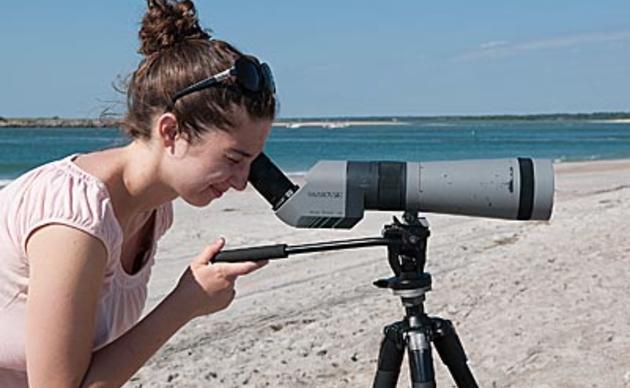Coastal Engineering
Coastal engineering presents a specific and complex threat to coastal bird species and their habitats.
These projects eliminate habitat for migrating and wintering birds including the Least Tern, Common Tern, Short-billed Dowitcher, Caspian Tern, Western Sandpiper, Black Skimmer, Piping Plover (which is listed federally as “threatened), Wilson’s Plover, American Oystercatcher, Red Knot and Sanderling. They eliminate habitat for migrating and wintering birds including Piping Plovers (federally listed as “threatened”), Red Knots (candidate for listing under Endangered Species Act), and many other species of shorebirds.
Negative Impacts
Coastal beaches, inlets and bayside flats have been negatively impacted by coastal engineering and shoreline stabilization projects. Fifty-four percent of inlets in the southeastern United States have been modified by sand mining, channelization or hardened structures. North Carolina has the second greatest percentage of altered inlets in the southeastern United States (North Carolina, South Carolina, Georgia, Florida, Alabama, Mississippi, Louisiana, and Texas), at 85 percent.
Alterations to the coastline eliminate habitat and hinder or prevent natural processes that create new habitat and allow coastal habitats to adapt over time in response to sea level rise. They also reduce prey abundance and can render the seafloor unsuitable for re-colonization by prey species.
With increasing frequency, birds are forced to eke out an existence in poor quality habitats where they suffer from low nesting productivity, inadequate food, poor fitness and increased mortality. If the trend continues, the eventual crash in some coastal bird populations is inevitable. The threat of extirpation or possibly extinction is looming for a few.
Protecting Coastal Habitat
The habitat that remains is critical to sustaining bird populations and it is essential that Audubon work to protect these habitats. While the establishment of National Seashores, coastal wildlife refuges, state-owned wildlife management areas, and sanctuaries protected by non-governmental organizations have protected important habitat in key areas, it is not enough.
Audubon works to protect essential habitats for target species through acquisition, easements, cooperative agreements, partnerships, and any other site-appropriate method that provides the best possible protection for the site. We attempt to influence land-use policies that provide the best possible protection of target species and the habitats they depend on during breeding, migration, and winter.
Audubon also applies the best available habitat restoration techniques to restore degraded habitats and works to improve upon the current methods of habitat restoration by using Audubon sanctuaries as laboratories for studying new methods for restoring coastal habitats.
Program Collaboration
Audubon NC works with its partners and allies along the coast to positively impact project plans or to stop construction.
A state and federal regulatory nexus for coastal engineering projects to be subjected to a full EIS (and the equivalent state review) is needed when priority sites, species and habitats are involved. Regulatory agencies should consider the direct, indirect and cumulative impacts of projects on coastal habitats.
A case statement and model policy should be developed for future and cumulative impacts of coastal engineering projects with consideration for known impacts of coastal engineering practices and sea level rise predictions. Further, best management practices for coastal engineering projects should be developed that avoid impacts and/or minimize impacts to coastal habitats.
Protecting Rich Inlet
For example, Audubon NC has joined with a coalition of other conservation organizations and property owners to protect Rich Inlet. Located just north of Figure Eight Island, Rich Inlet is one of the few naturally functioning inlets left in the state. It moves between the north end of Figure Eight Island and Lea-Hutaff Island, one of the state’s few remaining un-bridged, undeveloped barrier islands.
The inlet is now being threatened by a proposal by the Figure Eight Island Homeowners Association to build a terminal groin at the north end of the island. The U.S. Fish & Wildlife Service designates the land created by the inlet’s movement “critical nesting habitat” for threatened piping plovers. More than 800 pairs of least terns – the largest colony in North Carolina in more than 40 years - were nesting on the beach in 2014.
The proposed groin would be a rock wall 80 feet wide. It would span 1,500 feet, about 300 feet of which would cross coastal wetland and block Rich Inlet’s natural function.
The proposed hardened structure along this natural beach and inlet system threatens to destroy critical habitat for fish, birds and sea turtles. It would also eliminate treasured public trust areas used by thousands of people every year for fishing, boating, barbequing and swimming.
Due to the natural dynamics of the inlet, erosion at the northern end of the island is no longer threatening the multi-million dollar homes. The sand is actually accreting, and so the groin is no longer needed.
The N.C. Coastal Federation, N.C. Audubon, PenderWatch & Conservancy and the Southern Environmental Law Center have teamed up to create a public awareness campaign to save Rich Inlet and stop this project from moving forward.
Did this issue get you fired up? Sign-up for our NC Action Alert network to stay informed as we work to protect birds in North Carolina.
How you can help, right now
Donate to Audubon
Help secure the future for birds at risk from climate change, habitat loss and other threats. Your support will power our science, education, advocacy and on-the-ground conservation efforts.
Sign Up For Our eNewsletter
Keep up-to-date on all that happens with Audubon North Carolina's research, events and volunteer opportunities.




